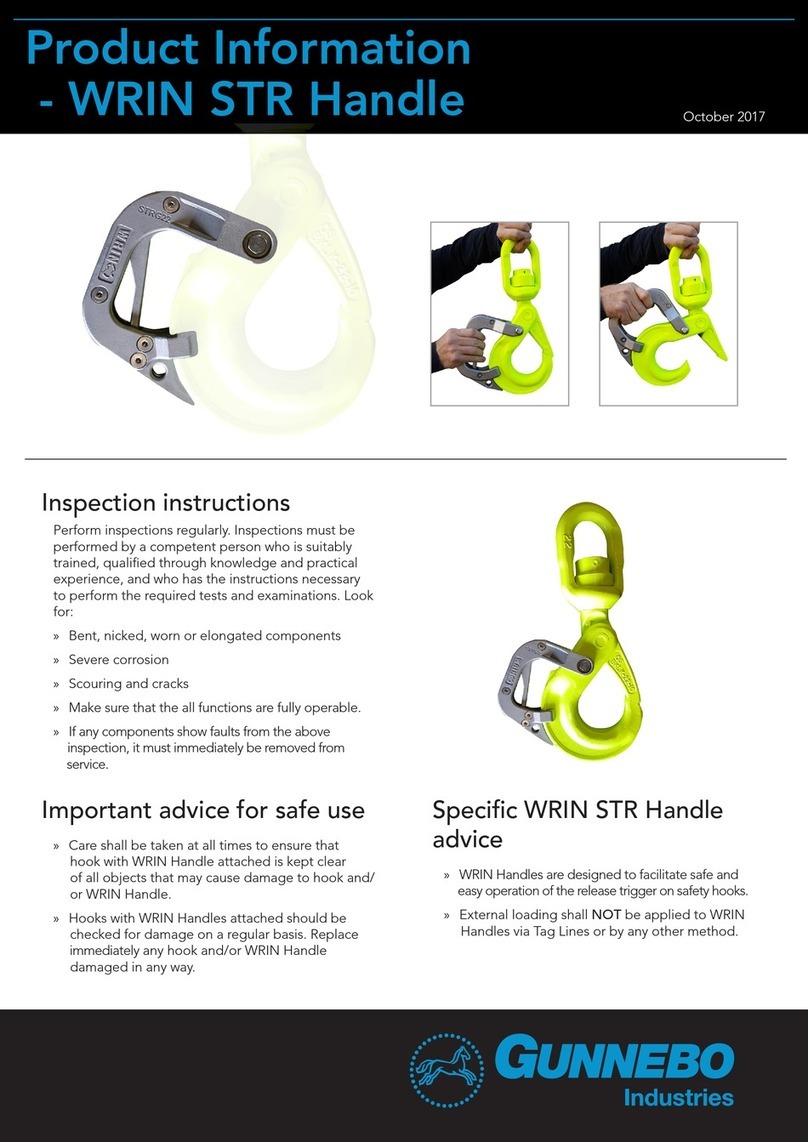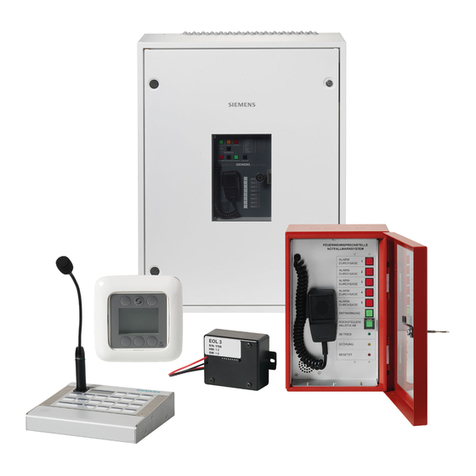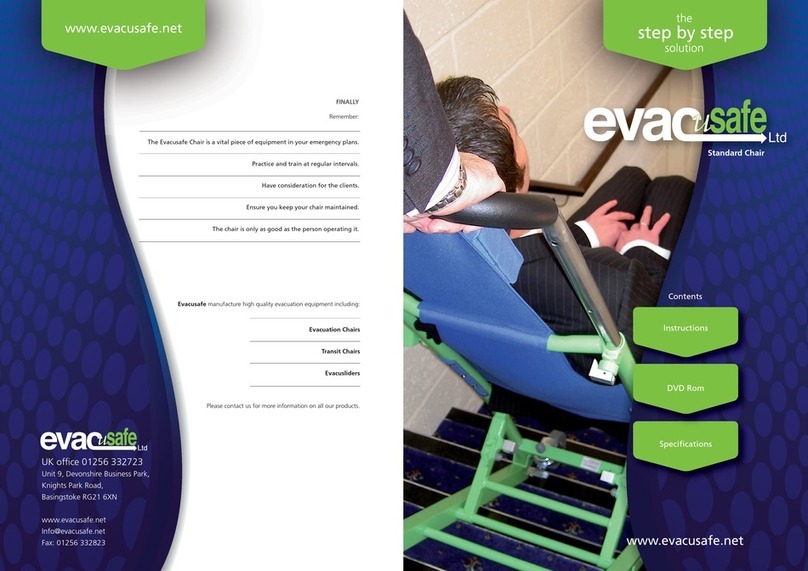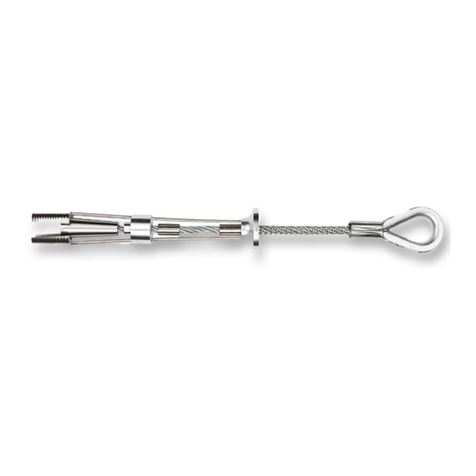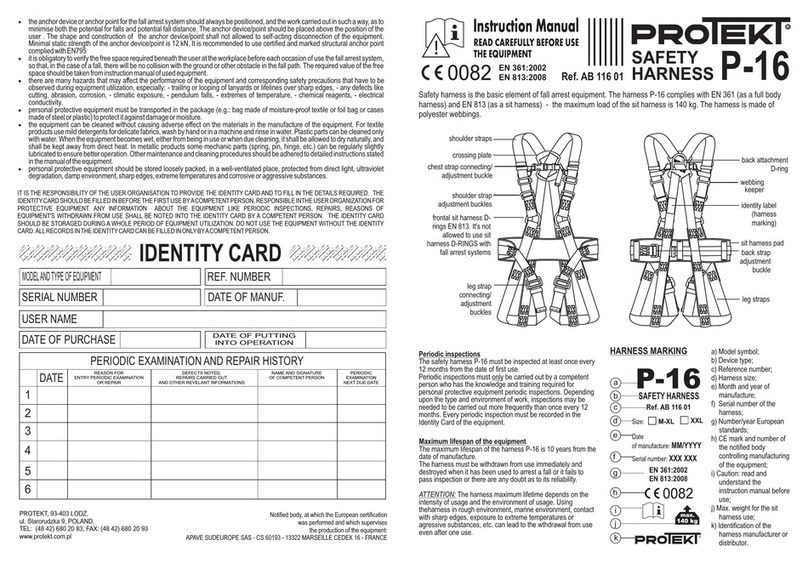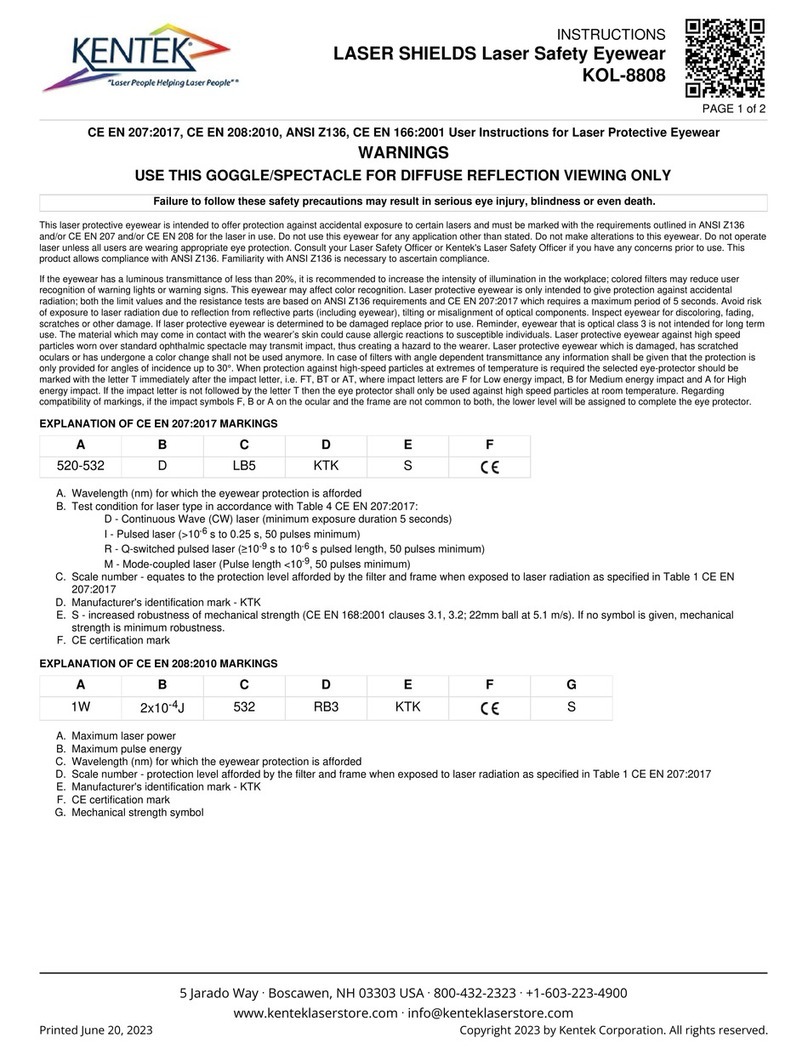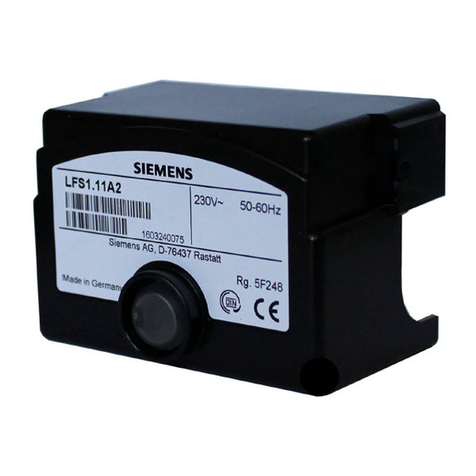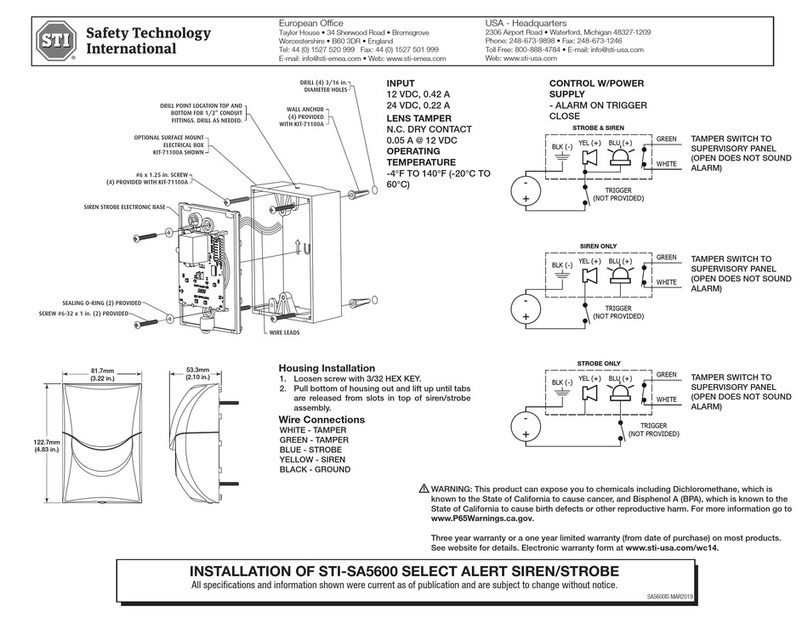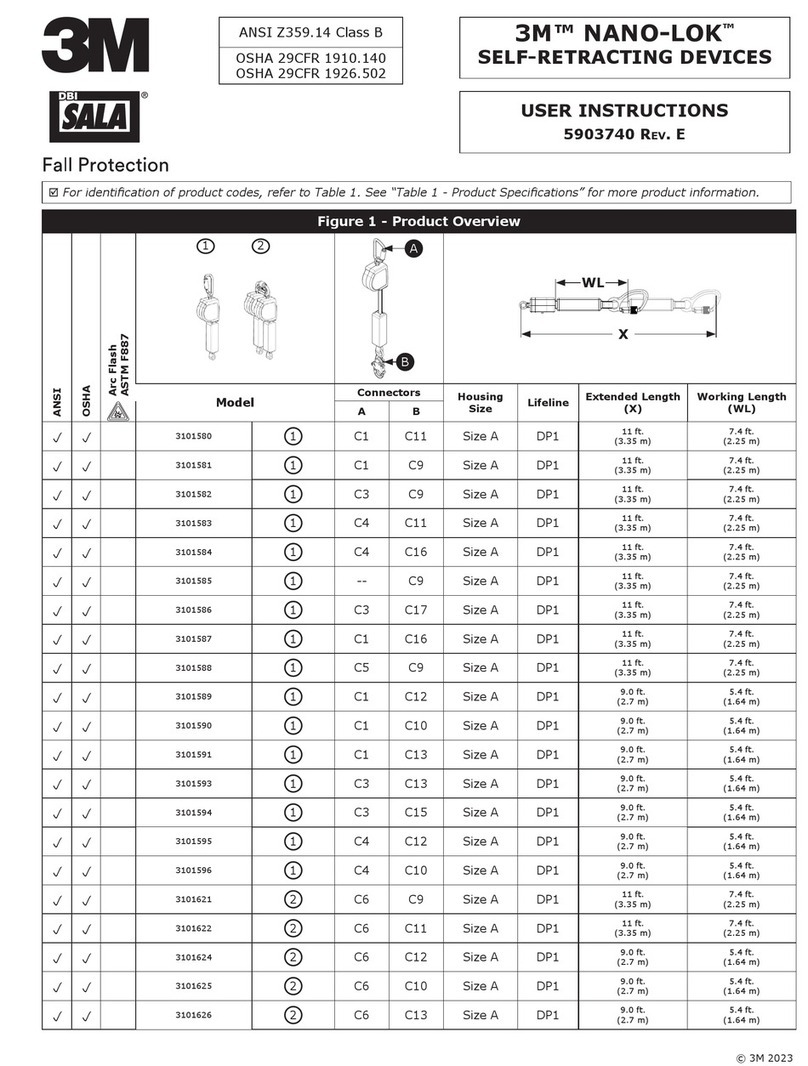ROOTS FRA-19 Instruction Manual

Trital FRA-19 - instructies 05/2022 1 / 15
Ref : FRA-19
Instructies voor de gebruiker :
0493
0120
Antistatische beschermkleding (één of
tweedelig) voor werknemers blootgesteld aan
hitte en vuur (exclusief lassers), volgens de
Europese normen :
-EN ISO 13688:2013
-EN 1149-5:2018
-EN ISO 11612:2015
-EN 61482-2:2020
EN ISO 11612:2015
A1 A2 B1 C1 D0 E0 F1
EN 1149-5:2018
EN61482-2:2020
ELIM = 4.6 cal/cm² /
ATPV = 5.4 cal/cm²
Dit kledingpakket is ontworpen op basis van de geldende (Europese) normen EN ISO
13688:2013, EN 1149-5:2018, EN ISO 11612:2015, EN 61482-2:2020.
Type keuring heeft aangetoond dat de kleding voldoet aan de fundamentele vereisten zoals
beschreven in de Europese verordening (EU) 2016/425 voor persoonlijke
beschermingsmiddelen.
Voor de conformiteitsverklaring zie : www.roots-original.com/certificates
De type keuring en certificatie, evenals de kwaliteitsopvolging van dit beschermingsmiddel
is uitgevoerd door : SGS Fimko, Topeliuksenkatu 41 b, FI-00250 Helsinki, Finland (notified
body met identificatie nummer : N.B. 0598)
De markering UKCA is enkel van toepassing voor Groot-Brittannië. Dit wordt dan ook enkel
in de Engelse versie van de instructies volledig toegelicht.

Trital FRA-19 - instructies 05/2022 2 / 15
Lees deze instructies voor het eerste gebruik zorgvuldig door en hou deze bij voor het geval
u later nog informatie nodig zou hebben.
Toepassing van de kleding
Deze kleding voldoet aan de norm EN ISO 11612 (Beschermende kleding - Kleding voor
bescherming tegen hitte en vlammen (exclusief brandweer en lassers). Dit betekent dat de
drager beschermd is tegen kortstondige contacten met een vlam en (tot op zekere hoogte)
tegen convectie-, stralings- en contactwarmte.
Classificatie systeem :
A1 : buitenmateriaal getest op vlamverspreiding volgens EN15025 procedure A (vlam op het
oppervlak)
A2 : buitenmateriaal getest op vlamverspreiding volgens EN15025 procedure B (vlam op de
rand)
Bn : convectiewarmte : 3 niveaus waarbij 1 het laagst is
Cn : stralingswarmte : 4 niveaus waarbij 1 het laagst is
Dn : spatten van gesmolten aluminium : 3 niveaus waarbij 1 het laagst is
En : spatten van gesmolten ijzer : 3 niveaus waarbij 1 het laagst is
Fn : contactwarmte : 3 niveaus waarbij 1 het laagst is
opmerking: wanneer n gelijk is aan 0, betekent dit dat de kleding geen bescherming biedt
voor dit soort gevaren.
Deze kledingstukken voldoen ook aan de eisen van norm EN 61482-2 (beschermende
kleding tegen de thermische gevaren van een elektrische vlamboog).
ATPV en ELIM = xx cal / cm² zijn het resultaat van de open arc test. ATPV staat voor Arc
Thermal Performance Value en is de incident energie waarbij maximaal 50% kans is dat
tweede graad brandwonden kunnen optreden en dit zonder openbreken van het materiaal.
ELIM staat voor incident limit waaronder er geen testresultaten beschikbaar zijn over
warmtetransmissie die leidt tot tweede graad brandwonden of openbreken van het
materiaal.
Zowel materiaal als kleding zijn getest.
Alle modellen uit dit assortiment voldoen aan de norm EN 1149-5 (antistatische
beschermkleding - materiaal getest volgens EN 1149-3). Dit betekent dat de kleding
ontworpen is om elektrostatische ladingen af te leiden, dit om te vermijden dat vonken
ontstaan die brand en/of explosies zouden kunnen veroorzaken. De eisen hiervoor
aangewend zijn echter niet streng genoeg voor zuurstofrijke ontvlambare omgevingen. De
kleding is ook niet ontworpen om te beschermen tegen netspanning.
Correct gebruik van de kleding
Zelfs indien u aangepaste beschermende kleding draagt, moet u er toch rekening mee
houden dat uw veiligheid niet in alle omstandigheden kan gegarandeerd worden en dat u
zelf verantwoordelijk blijft voor uw veiligheid. Gelieve dan ook het volgende in acht te
nemen :
-Deze kledingstukken zijn ontworpen om het hele lichaam te beschermen. Daarom is
het noodzakelijk dat u een volledig pak draagt (overall of tweedelig pak). Bij een
tweedelig pak kunnen de onderdelen van het pak apart verkocht of geleverd worden.
Bij het ontwerp van tweedelige pakken (jas en broek) wordt gezorgd voor voldoende
overlap en dit bij alle voorzienbare bewegingen. Houd rekening met deze minimale
overlap bij het kiezen van de juiste maat.
-Om tijdens uw werkzaamheden beschermd te zijn is het van cruciaal belang dat u de
kledingstukken te allen tijde gesloten houdt. Dit betekent ook dat u de aanpassingen
aan polsen, enkels en/of taille moet benutten. Deze aanpassingen zorgen voor een

Trital FRA-19 - instructies 05/2022 3 / 15
goed contact tussen uw lichaam en het geleidende materiaal, wat essentieel is om
ontlading van elektrostatische ladingen te verkrijgen.
-Indien de kleding voorzien is van een kap moet deze tijdens de werkzaamheden
opgezet worden of opgeborgen zijn in de kraag indien die mogelijkheid voorzien is.
-Voor een volledige bescherming dient u bijkomende persoonlijke
beschermingsmiddelen te dragen voor handen, voeten en gelaat.
-Bevuiling van de kleding met ontvlambare producten kan de eigenschappen van het
weefsel wijzigen. Regelmatig en zorgvuldig onderhoud zorgt voor de blijvende
efficiëntie van de kleding. De kleding mag niet worden opgeslagen in solventen,
wasoplossingen, desinfecterende of ontvlekkende producten. Sla geen bevuilde
kleding op – laat ze reinigen voor opslag.
-Als uw kleding in contact komt met gesmolten metaal, moet u de werkplek verlaten
en de kleding verwijderen. In dit geval kunnen risico's op brandwonden niet worden
uitgesloten als de kleding direct op de huid wordt gedragen.
-Deze kleding biedt geen bescherming tegen chemicaliën, in welke vorm dan ook.
Indien er accidenteel spatten van chemicaliën op de kleding terecht zouden komen
dient u deze onmiddellijk uit te trekken, erop lettend dat het chemisch product niet
in contact komt met uw huid. Bezorg de kleding afzonderlijk aan de
verantwoordelijke voor het onderhoud ervan zodat andere kleding niet in contact
komt met het chemisch product. De verantwoordelijke voor het onderhoud zal de
nodige maatregelen treffen om de kleding op gepaste wijze te reinigen of indien
nodig te vervangen.
-Bij het ontwerp van de kleding is ervoor gezorgd dat alle metalen onderdelen
afgedekt zijn aangebracht, dit om het ontstaan van vonken te voorkomen. Zorg er
dan ook voor dat u bij het dragen van de kleding geen metalen onderdelen
onafgedekt laat (bv bij het dragen van een ceintuur ervoor zorgen dat deze geen
metalen onderdelen zoals een gesp heeft). U moet er ook op letten dat de kleding in
alle omstandigheden alle onderliggende kleding afdekt (dus ook als u
voorovergebogen werkt bijvoorbeeld).
-Om de ontlading van elektrostatische ladingen te garanderen, moeten de
kledingstukken op de een of andere manier worden geaard (maximale weerstand 108
Ohm). Contact tussen de geleidende kledingstukken en geleidende schoenen zal
deze ontlading zeker versterken. In ieder geval is een correcte aarding essentieel.
-Uw elektrostatisch dissipatief kledingstuk is bedoeld om te worden gedragen in zone
1, 2, 20, 21 en 22 (zie EN 60079-10-1 [7] en EN 60079-10-2 [8]) waarin de
minimale ontstekingsenergie van elke explosieve atmosfeer niet minder dan 0,016
mJ is.
-Elektrostatisch dissipatieve beschermende kleding mag niet worden gebruikt in een
met zuurstof verrijkte atmosfeer of in zone 0 (zie EN 60079-10-1 [7]) zonder
voorafgaande goedkeuring van de verantwoordelijke veiligheidsverantwoordelijke.
-Terwijl u deze kledingstukken in een ATEX-omgeving draagt, mag u geen accessoires
of uitrusting aan de buitenkant van de kledingstukken bevestigen of aankoppelen die
niet voldoen aan de vereisten voor materialen die in explosiegevaarlijke
omstandigheden worden gebruikt (εx materialen en uitrusting zoals voorzien in de
ATEX-vereisten ). Zorg ervoor dat u in dit soort omgevingen alleen explosieveilige
apparatuur gebruikt - uw mobiele telefoon kan bijvoorbeeld het beste buiten deze
zone worden gehouden of op zijn minst worden uitgeschakeld. Bevestig in ieder
geval geen materialen die metaal bevatten aan de buitenkant van de kledingstukken!
-De elektrostatische eigenschappen van de kleding kunnen beïnvloed worden door
gebruik, onderhoud en eventuele contaminatie. U moet uw kleding dan ook
regelmatig (laten) testen op deze eigenschappen.
-De kleding mag in geen geval worden uitgetrokken in een explosie gevaarlijke of
ontvlambare ruimte of tijdens het hanteren van ontvlambare of explosieve
substanties.
-Deze kledingstukken zijn niet ontworpen om u te beschermen tegen netspanning, in
dat geval moet u andere geschikte beschermingsmiddelen gebruiken.
-Kleding gedragen onder deze kleding (bv. t-shirt, ondergoed, …) mag niet
vervaardigd zijn uit materiaal dat kan smelten in geval van een incident met een

Trital FRA-19 - instructies 05/2022 4 / 15
vlamboog – dit is bijvoorbeeld het geval voor kleding gemaakt van polyamide,
polyester of acryl. Raadpleeg de veiligheidsverantwoordelijke in uw bedrijf in geval
van twijfel.
-Beschadiging van de kleding (bv. gaatjes, scheuren, ...) zal hoogst waarschijnlijk de
beschermende graad van de kleding verminderen. Controleer dan ook regelmatig
(bij voorkeur telkens u de kleding aantrekt) op beschadigingen of veroudering. Laat
indien nodig herstellen of vervangen. Ruwe mechanische en/of chemische
behandelingen verminderen de functionaliteit en de levensduur van de kleding.
-Mogelijke reparaties of aanpassingen (bijv. Het aanbrengen van badges / logo's)
moeten worden uitgevoerd door getraind personeel en alleen met gebruikmaking van
de originele materialen zoals gespecificeerd door de fabrikant op het moment van
certificatie en rekening houdend met de modelvereisten van de gebruikte normen.
Neem bij voorkeur contact op met uw leverancier voor meer informatie over de
mogelijkheden.
-Eventuele knieverstevigingen zijn enkel bedoeld om de stevigheid van de kleding ter
verhogen en/of om het comfort te verhogen, niet om bescherming te bieden tegen
mogelijke risico’s.
-Er zijn geen bekende gevallen van allergieën tegen de materialen gebruikt voor de
productie van deze kleding. De gebruikte materialen zijn – volgens de huidige
beschikbare informatie – niet carcinogeen, mutageen of toxisch voor de menselijke
voortplanting.
-De kleding is na gebruik geschikt voor recycling door de daarvoor aangewezen
kanalen.
-Het aanbrengen van specifieke afwerkingen zoals bijvoorbeeld wax of fluorcarbon
kan de beschermende eigenschappen van de kleding veranderen.
De leverancier is niet aansprakelijk voor schade, in welke vorm dan ook, voortvloeiend uit
onoordeelkundig gebruik of misbruik van deze kleding.
Maataanduiding (conform EN ISO 13688:2013)
A = totale lengte (cm)
B = borstomtrek (cm) – is aangegeven in geval van overall
en/of jas
C = lendenomtrek (cm) – is aangegeven in geval van
pantalon
Alle maten aangeduid in deze figuur zijn gemeten op de persoon – deze wijken dus af van
de maten van het kledingstuk.
Referentie
De referentie van het bij het notified body ter certificering ingediende technische dossier is
FRA-19, waar FR verwijst naar bescherming tegen hitte en vlammen, A naar antistatische
eigenschappen en 19 is een volgnummer.
Type kleding : x = J : jas/vest
x = T : pantalon/broek
x = O : overall

Trital FRA-19 - instructies 05/2022 5 / 15
Naast deze referentie vindt u ook een specifieke modelreferentie op het etiket van het
kledingstuk.
Onderhoud
De wasfrequentie van de gedragen kleding is afhankelijk van de bevuilingsgraad die varieert
naargelang de werkomstandigheden.
Enkele algemene richtlijnen :
-Bewaar nooit vuile kledingstukken.
-Om beschadiging tijdens het wassen te vermijden, is het aan te raden rits- en
klittenbandsluitingen te sluiten.
-Na het wassen dient de kleding voldoende gespoeld te worden om alle resten van de
wasmiddelen te verwijderen. In geen geval wasverzachter gebruiken.
-Vlekken kunnen het best zo snel mogelijk met een doekje gereinigd worden.
Hardnekkige vlekken kunnen eventueel lokaal met perchlooretheen behandeld
worden.
-Specifieke instructies voor industrieel onderhoud kunnen bij de producent bekomen
worden.
Testen in het laboratorium en zonder enige andere verouderingsfactor, hebben aangetoond
dat aan de vereisten voor de vlamverspreiding van de toegepaste normen (EN ISO 11612
en EN 61482-2) wordt voldaan na 50 wasbeurten volgens de vermelde wasvoorschriften.
Het vermelde maximale aantal wasbeurten is niet de enige factor die de levensduur van het
kledingstuk bepaalt. De levensduur hangt ook af van het gebruik, de manier van opslag,
enz.
Bijkomende nabehandelingen zijn niet nodig.
De maximale wastemperatuur bedraagt 60° C
Opmerking – wassen bij lagere temperaturen zal de levensduur van
de kleding gunstig beïnvloeden. De levensduur zal ook mee bepaald
worden door de aard en de dosering van de gebruikte wasmiddelen.
Mag niet gebleekt worden met bleekwater of andere bleekmiddelen
op basis van chloor.
Drogen in trommel bij verlaagde temperatuur toegestaan.
Strijken is toegelaten – maximale temperatuur van de zool van de
strijkbout : 150°C.
Chemisch reinigen toegestaan met de meeste gangbare
oplosmiddelen
Trital Safety BV
Mandenmakerstraat 41
3194 DA Hoogvliet
Nederland
Tel. : +31 10 29 55 955
www.roots-original.com

Trital FRA-19 - instructies 05/2022 6 / 15
REf : FRA-19
Instructions pour l’utilisateur :
0493
0120
Vêtements de protection (combinaison ou 2
pièces) antistatique pour les travailleurs
exposés à la chaleur et au feu (exclusif
soudeurs), selon les normes européennes :
-EN ISO 13688:2013
-EN 1149-5:2018
-EN ISO 11612:2015
-EN 61482-2:2020
EN ISO 11612:2015
A1 A2 B1 C1 D0 E0 F1
EN 1149-5:2018
EN61482-2:2020
ELIM = 4.6 cal/cm² /
ATPV = 5.4 cal/cm²
Cet ensemble de vêtements a été développé sur la base des normes (européennes) EN ISO
13688:2013, EN 1149-5:2018, EN ISO 11612:2015, EN 61482-2:2020.
L’examen de type a démontré que les vêtements satisfont aux exigences fondamentales
telles que décrites dans le règlement européenne (UE) 2016/425 sur les équipements de
protection individuelle.
Pour la déclaration de conformité : voir www.roots-original.com/certificates
L’examen de type et la certification, ainsi que la contrôle de qualité de ces vêtements de
protection est effectué par : SGS Fimko, Topeliuksenkatu 41 b, FI-00250 Helsinki, Finland
(organisme notifié avec numéro d’identification : N.B. 0598)
Le marquage UKCA ne s’applique qu’à la Grande-Bretagne. Ceci n’est donc expliqué en
détail que dans la version anglaise des instructions.

Trital FRA-19 - instructies 05/2022 7 / 15
Veuillez lire attentivement ces instructions avant la première utilisation, et conservez-les au
cas où vous en auriez besoin ultérieurement.
Application des vêtements
Ces vêtements sont conformes à la norme EN ISO 11612 (vêtements de protection contre
la chaleur et les flammes, à l'exclusion des soudeurs et pompiers). Cela signifie que
l'utilisateur est protégé contre les contacts courts avec une flamme ainsi que (dans une
certaine mesure) contre la chaleur convective, rayonnante et de contact.
Système de classification :
A1 : matériau extérieur testé pour la propagation des flammes selon la procédure A de la
norme EN15025 (flamme en surface)
A2 : matériau extérieur testé pour la propagation des flammes selon la procédure A de la
norme EN15025 (flamme sur le bord)
Bn : chaleur convective : 3 niveaux où 1 est le plus bas
Cn : chaleur rayonnante : 4 niveaux où 1 est le plus bas
Dn : éclaboussures d'aluminium fondu : 3 niveaux où 1 est le plus bas
En : éclaboussures de fer fondu: 3 niveaux où 1 est le plus bas
Fn : chaleur de contact : 3 niveaux où 1 est le plus bas
remarque: lorsque n est égal à 0, cela signifie que les vêtements n'offrent pas de protection
pour ce type de risque.
Ces vêtements répondent également aux exigences de la norme EN 61482-2 (vêtements
de protection contre les risques thermiques d'un arc électrique).
ATPV et ELIM = xx cal / cm² sont le résultat du test à l'arc ouvert. ATPV signifie Arc
Thermal Performance Value et est l'énergie incidente qui se traduit par une probabilité
maximale de 50% qu'un transfert de chaleur suffisant à travers l'éprouvette testée
provoque le déclenchement d'une brûlure cutanée au deuxième degré sans ouverture du
matériau. ELIM signifie limite d'incident en dessous de laquelle aucun résultat de test n'est
disponible sur la transmission de chaleur conduisant à une brûlure cutanée au deuxième
degré ou à une ouverture du matériau.
Le matériel et les vêtements ont été testés.
Tous les modèles de cet assortiment satisfont à la norme EN 1149-5 (vêtements de
protection antistatiques – matériel testé selon EN 1149-3). Cela signifie que les vêtements
ont été conçus pour détourner des charges électrostatiques, afin d’éviter que des étincelles,
pouvant provoquer un incendie et/ou des explosions, se produisent. Les exigences
d’application à cet effet ne sont cependant pas assez sévères pour les environnements
inflammables riches en oxygène. Les vêtements n’ont pas non plus été conçus pour offrir
une protection contre la tension de réseau.
Utilisation correcte des vêtements
Même si vous portez des vêtements de protection adéquats, vous devez quand même tenir
compte du fait que votre sécurité ne peut pas être garantie en toutes circonstances et que
vous restez responsable de votre sécurité.
Aussi, veuillez tenir compte de ce qui suit :
-Ces vêtements sont conçus pour protéger l'ensemble de votre corps. Par conséquent,
il est nécessaire que vous portiez un costume complet (combinaison ou ensemble 2
pièces). Dans le cas d'un ensemble 2 pièces, les pièces peuvent être vendues ou
livrées séparément. Dans la conception des ensembles 2 pièces (veste et pantalon),
un chevauchement adéquat est assuré et cela, pendant tous les mouvements
prévisibles. Tenez compte de ce chevauchement minimum tout en choisissant votre
taille correcte.
-Afin d'être protégé pendant vos activités, il est primordial de garder les vêtements
fermés à tout moment. Cela signifie également que vous devez utiliser les réglages

Trital FRA-19 - instructies 05/2022 8 / 15
fournis au niveau des poignets, des chevilles et / ou de la taille. Ces réglages
assurent un bon contact entre votre corps et le matériau conducteur, indispensable
pour obtenir la décharge des charges électrostatiques.
-Si le vêtement a une capuche, assurez-vous que la capuche est portée correctement
(avec les ajustements fournis) ou nichée dans le col si cette possibilité est offerte
pendant vos activités
-Pour une protection complète, vous devez porter des équipements de protection
individuelle supplémentaires pour les mains, les pieds et le visage.
-Les vêtements souillés (par exemple avec des produits inflammables) n'auront pas
les mêmes caractéristiques de protection. Par conséquent, un nettoyage et un
entretien réguliers et soignés garantiront l'efficacité des vêtements. Ne pas stocker
les vêtements dans des solvants, des solutions de lavage, des produits désinfectants
ou détachants. Ne stockez pas les vêtements souillés - faites-les nettoyer avant de
les ranger.
-Si vos vêtements entrent en contact avec du métal en fusion, vous devez quitter le
lieu de travail et retirer les vêtements. Dans ce cas, les risques de brûlures ne
peuvent pas être exclus si les vêtements sont portés directement sur la peau.
-Ces vêtements n'offrent aucune protection contre les produits chimiques, sous
aucune forme que ce soit. Si vos vêtements entrent accidentellement en contact
avec des projections de produits chimiques, vous devez les retirer immédiatement,
en veillant à ce que le produit chimique ne touche pas votre peau. Remettez le
vêtement à la personne en charge de l'entretien séparément afin qu'aucun autre
vêtement n'entre en contact avec le produit chimique. Le responsable de son
entretien prendra les mesures nécessaires pour nettoyer adéquatement les
vêtements ou, si nécessaire, les remplacer.
-Au stade de la conception, le fabricant s'est assuré que toutes les pièces métalliques
sont recouvertes pendant l'utilisation normale - ceci pour éviter la génération
d'étincelles. Assurez-vous que lorsque vous portez ces vêtements, toutes les parties
métalliques des accessoires (par exemple, la ceinture peut ne pas avoir de boucle
métallique) sont couvertes à tout moment. Assurez-vous également que ces
vêtements de protection couvrent complètement vos vêtements sous-jacents à tout
moment (cela signifie également lorsqu'ils sont pliés par exemple).
-Pour assurer la décharge des charges électrostatiques, les vêtements doivent être
mis à la terre dans un sens ou dans l'autre (résistance maximale 108Ohm). Le
contact entre les vêtements conducteurs et les chaussures conductrices améliorera
certainement cette décharge. Dans tous les cas, une mise à la terre correcte est
indispensable.
-Votre vêtement dissipateur électrostatique est destiné à être porté dans les zones 1,
2, 20, 21 et 22 (voir EN 60079-10-1 [7] et EN 60079-10-2 [8]) dans lesquelles
l'énergie d'allumage minimale de toute atmosphère explosive n'est pas inférieure à
0,016 mJ.
-Les vêtements de protection dissipatifs électrostatiques ne doivent pas être utilisés
dans des atmosphères enrichies en oxygène ou dans la zone 0 (voir EN 60079-10-1
[7]) sans l'approbation préalable du responsable de sécurité.
-Lorsque vous portez ces vêtements dans un environnement ATEX, ne fixez pas ou
n'attachez pas d'accessoires ou d'équipements à l'extérieur des vêtements qui ne
répondent pas aux exigences pour les matériaux à utiliser dans des conditions
explosives (matériaux et équipements εx comme prévu dans les exigences ATEX).
Assurez-vous d'utiliser dans ce type d'environnements uniquement des équipements
antidéflagrants - par exemple, votre téléphone portable doit être conservé en dehors
de cette zone ou au moins éteint. Dans tous les cas, ne fixez aucun matériau
contenant du métal à l'extérieur des vêtements!
-Les propriétés électrostatiques des vêtements peuvent être influencées par
l'utilisation, l'entretien, l'entretien et une éventuelle contamination. Assurez-vous
d'évaluer ou d'avoir évalué les propriétés régulièrement.
-En aucun cas, vous ne devez retirer ce type de vêtements dans une atmosphère
explosive ou inflammable ou en manipulant des substances inflammables ou
explosives.

Trital FRA-19 - instructies 05/2022 9 / 15
-Ces vêtements ne sont pas conçus pour vous protéger contre la tension secteur,
dans ce cas, vous devez utiliser un autre équipement de protection approprié.
-Les vêtements portés sous ces vêtements (par exemple, t-shirt, sous-vêtements, ...)
ne doivent pas être faits de matériaux qui pourraient fondre sous l'exposition à l'arc -
ce sera le cas pour les vêtements fabriqués par exemple en polyamide, polyester ou
acrylique. Consultez le responsable de la sécurité de votre entreprise en cas de
doute.
-Des dommages tels que des trous ou des déchirures affecteront très probablement
les propriétés protectrices des vêtements. Assurez-vous de vérifier régulièrement vos
vêtements (de préférence à chaque fois avant de les mettre) pour déceler des
dommages ou un vieillissement. Au besoin, faites-les réparer ou remplacer. Une
action mécanique ou chimique rugueuse (par exemple pendant le lavage) diminuera
la fonctionnalité et la durée de vie des vêtements.
-Les réparations ou ajustements éventuels (par exemple, la fixation de badges /
logos) doivent être effectués par du personnel qualifié et en utilisant uniquement les
matériaux d'origine tels que spécifiés par le fabricant au moment de la certification
et en tenant compte des exigences du modèle des normes utilisées. Contactez de
préférence votre fournisseur pour plus d'informations sur les possibilités.
-Si des genouillères sont incorporées dans les vêtements, elles sont uniquement
conçues pour améliorer votre confort et / ou la résistance du vêtement - pas pour
vous protéger contre d'éventuels risques spécifiques pour vos genoux.
-Il n'y a aucun cas connu d'allergies aux matériaux utilisés pour la fabrication de ces
vêtements. Les matériaux utilisés ne sont pas, selon les informations actuellement
disponibles, cancérigènes, mutagènes ou toxiques pour la reproduction humaine.
-Après utilisation, les vêtements peuvent être recyclés en utilisant les moyens
spécialisés appropriés.
-L'application de finitions spécifiques telles que par exemple des cires ou du carbone
fluoré peut altérer les propriétés protectrices des vêtements.
Le fournisseur n’est pas responsable de dommages, sous quelque forme que ce soit,
découlant d’une utilisation peu judicieuse ou incorrecte de ces vêtements.
Indication de la taille (conformément EN ISO 13688:2013)
A = longueur totale (cm)
B = tour de poitrine (cm) – indiqué pour une combinaison
et/ou une veste
C = tour de taille (cm) – indiqué pour un pantalon
Toutes les mensurations indiquées dans cette illustration sont mesurées sur la personne –
elles divergent donc des mensurations du vêtement.
Référence
La référence du dossier technique soumis pour certification à l'organisme notifié est FRA-19
où FR fait référence à la protection contre la chaleur et les flammes, A fait référence aux
propriétés antistatiques et 19 est un numéro de rotation.
Type de vêtement : x = J : veste
x = T : pantalon
x = O : combinaison

Trital FRA-19 - instructies 05/2022 10 / 15
En plus de cette référence, vous pouvez également trouver une référence de modèle
spécifique sur l'étiquette du vêtement.
Entretien
La fréquence de lavage des vêtements utilisés dépend du degré de saleté qui varie en
fonction des conditions de travail.
Quelques conseils généraux :
-Ne stockez jamais de vêtements sales.
-Afin d’éviter tout dommage pendant le lavage, il est conseillé de fermer les
fermetures éclair et les fermetures velcro.
-Après le lavage, les vêtements doivent être soigneusement rincés pour supprimer
tous les résidus du produit de lessive. N’utilisez en aucun cas un assouplissant.
-Il est conseillé d’enlever les taches le plus vite possible avec un chiffon. Les taches
tenaces peuvent éventuellement être traitées localement avec du perchloréthylène.
-Vous pouvez obtenir des instructions spécifiques pour l’entretien industriel auprès du
fabricant.
Des essais en laboratoire ont démontré que le vêtement est conforme aux exigences pour la
propagation de flamme limitée comme prévu dans la norme EN ISO 11612 EN 61482-2
après 50 cycles de lavage comme indiqué dans l’étiquette.
Le nombre maximum de cycles de nettoyage indiqué n'est pas le seul facteur lié à la durée
de vie du vêtement. La durée de vie dépendra également de l'utilisation, du mode de
stockage, etc.
Aucun traitement ultérieur n’est requis.
La température de lavage maximale s’élève à 60°C.
Remarque : un lavage à une température inférieure aura une influence
positive sur la durée de vie des vêtements. La durée de vie sera aussi
déterminée par la nature et le dosage des produits de lessive utilisés.
Ne pas blanchir avec de l’eau de javel ou d’autres agents de blanchiment à
base de chlore.
Séchage en tambour avec température réduit.
Repassage autorisé – température maximale de la semelle du fer à repasser
: 150°C.
Nettoyage à sec autorisé avec les solvants courants.
Trital Safety BV
Mandenmakerstraat 41
3194 DA Hoogvliet
Les Pays-Bas
Tél. : +31 10 29 55 955
www.roots-original.com

Trital FRA-19 - instructies 05/2022 11 / 15
Ref : FRA-19
Instructions for the user :
0493
0120
Antistatic protective clothing (one or two pieces)
for industrial workers exposed to heat and flame
(excluding welders), according to the European
standards :
-EN ISO 13688:2013
-EN 1149-5:2018
-EN ISO 11612:2015
-EN 61482-2:2020
EN ISO 11612:2015
A1 A2 B1 C1 D0 E0 F1
EN 1149-5:2018
EN61482-2:2020
ELIM = 4.6 cal/cm² /
ATPV = 5.4 cal/cm²
This range of garments is designed in line with the applicable European standards EN ISO
13688:2013, EN 1149-5:2018, EN ISO 11612:2015, and EN 61482-2:2020.
CE : Conformity assessment has shown that the clothing complies with the fundamental
requirements as described in European Regulation (EU) 2016/425 on personal protective
equipment.
The type examination and certification, as well as the quality control, of this protective
equipment was carried out by : SGS Fimko, Topeliuksenkatu 41 b, FI-00250 Helsinki,
Finland (notified body with identification number : N.B. 0598).
UKCA : Conformity assessment has shown that the clothing complies with the fundamental
requirements as described in Regulation 2016/425 on personal protective equipment, as
amended to apply in GB.

Trital FRA-19 - instructies 05/2022 12 / 15
The type examination and certification, as well as the quality control, of this protective
equipment was carried out by : SGS United Kingdom, Rossmore Business Park, Ellesmere
Port, South Wirral, Chesire CH65 3EN, UK (approved body with identification number :
0120).
For declaration of conformity : see www.roots-original.com/certificates
Please make sure to read these instructions carefully before the first use of the garments
and keep them for future reference.
Application of the garments
These garments comply with standard EN ISO 11612 (protective clothing to protect
against heat and flame, excluding welders and firefighters). This means that the wearer is
protected against short contacts with a flame as well as (to a certain extend) against
convective, radiant and contact heat.
Classification system :
A1 : outer material tested for flame spread according to EN15025 procedure A (flame on the
surface)
A2 : outer material tested for flame spread according to EN15025 procedure B (flame on the
edge)
Bn : convective heat : 3 levels where 1 is the lowest
Cn : radiant heat : 4 levels where 1 is the lowest
Dn : spatter of molten aluminium : 3 levels where 1 is the lowest
En : spatter of molten iron : 3 levels where 1 is the lowest
Fn : contact heat : 3 levels where 1 is the lowest
remark : when n equals 0, this means that the garments are not offering protection for this
type of hazard.
These garments also fulfil the requirements of standard EN 61482-2 (protective clothing
against the thermal hazards of an electric arc).
ATPV and ELIM = xx cal/cm² are the result of the open arc test. ATPV means Arc Thermal
Performance. Value and is the incident energy that results in a 50% probability that
sufficient heat transfer through the tested specimen is predicted to cause the onset of a
second-degree skin burn injury without break open of the material. ELIM stands for incident
limit below which there are no test results available on heat transmission leading to second-
degree skin burn or break open of the material.
Both material and clothing have been tested.
All garments from this range comply with the standard EN 1149-5 (antistatic clothing -
tested according EN 1149-3 method). This means that the garments are designed to
discharge electrostatic charges in order to prevent the generation of sparks that could cause
fire and/or explosions. However, these requirements are not sufficient in oxygen enriched
flammable atmospheres. Neither are the garments designed to protect against mains
voltages.
Correct use of the garments
Even while wearing appropriate protective clothing, you need to be aware of the fact that
your safety can not be guaranteed in all circumstances and that you remain responsible for
your own safety. Please do take the following into account :
-These garments are designed to protect the whole of your body. Therefore it is
necessary that you wear a full body suit (coverall or 2-piece suit). In the case of a 2-
piece suit, the parts of the suit can be sold or delivered separately. In the design of
2-piece suits (jacket and trousers) an adequate overlap is ensured and this during all

Trital FRA-19 - instructies 05/2022 13 / 15
foreseeable movements. Take this minimum overlap into account while choosing
your correct size.
-In order to be protected during your activities, it is crucial that you keep the
garments closed at all times. This also means that you need to use the adjustments
provided at your wrists, ankles and/or waist. These adjustments ensure a good
contact between your body and the conductive material, which is essential to obtain
discharge of electrostatic charges.
-If the garment has a hood, make sure the hood is either worn correctly (with the
adjustments provided) or tucked away in the collar if that possibility is provided
during your activities.
-For a complete protection you will need to wear additional personal protective
equipment for your hands, feet and face.
-Garments soiled (e.g. with flammable products) will not have the same protective
characteristics. Therefore regular and careful cleaning and maintenance will ensure
the efficiency of the clothing. Do not store the garments in solvents, washing
solutions, disinfecting or stain removing products. Do not store the clothing when
soiled-have them cleaned before storage.
-If your clothes should come into contact with molten metal, you must leave the
working place and remove the clothes. In this case risks on burns cannot be
excluded if the clothes are worn directly on the skin.
-This clothing offers no protection against chemicals, in no form whatsoever. If your
clothes should accidentally come into contact with chemical spatter, you must
remove them immediately, taking care that the chemical does not touch your skin.
Give the clothing to the person in charge of its maintenance separately so that no
other clothing comes into contact with the chemical. The person in charge of its
maintenance will take the necessary measures to adequately clean the clothing or, if
necessary, replace it.
-At the design stage the manufacturer ensured that all metallic parts are covered
during the normal use - this to prevent the generation of sparks. Do make sure that
while wearing this clothing all metallic parts of accessories (for instance the belt may
not have a metallic buckle) are covered at all times. Also make sure that these
protective garments completely cover your underlying clothing at all times (this
means also when bent over for instance).
-To ensure discharge of electrostatic charges, the garments need to be earthed one
way or the other (maximum resistance 108Ohm). Contact between the conductive
garments and conductive footwear will certainly enhance this discharge. In any case,
a correct earthing is essential.
-Your electrostatic dissipative garment is intended to be worn in Zones 1, 2, 20, 21
and 22 (see EN 60079-10-1 [7] and EN 60079-10-2 [8]) in which the minimum
ignition energy of any explosive atmosphere is not less than 0,016 mJ
-electrostatic dissipative protective clothing shall not be used in oxygen enriched
atmospheres, or in Zone 0 (see EN 60079-10-1 [7]) without prior approval of the
responsible safety engineer
-While wearing these garments in an ATEX environment, do not attach or hitch
accessories or equipment to the outside of the garments that do not meet the
requirements for materials to be used in explosion hazardous conditions (εx
materials and equipment as foreseen in the ATEX requirements). Make sure to use in
this type of environments only explosion safe equipment - for instance your mobile
phone is best kept outside this zone or at least switched off. In any case, do not
attach any materials that contain metal to the outside of the garments !
-The electrostatic properties of the garments can be influenced by use, care,
maintenance and possible contamination. Make sure you evaluate or have evaluated
the properties on a regular basis.
-Under no circumstances you should take this type of clothing off in an explosive or
inflammable atmosphere or while handling inflammable or explosive substances.
-These garments are not designed to protect you against mains voltage, in that case,
you need to use other appropriate protective equipment.

Trital FRA-19 - instructies 05/2022 14 / 15
-Clothing worn under these garments (e.g. t-shirt, underwear, ...) shall not be made
of materials that could melt under arc exposures - this will be the case for garments
made of e.g. polyamide, polyester or acrylic. Consult with the safety responsible in
your company in case of doubt.
-Damage such as holes or tears will most likely affect the protective properties of the
clothing. Make sure to check your garments regularly (preferably each time before
you put your garments on) for damage or ageing. If required have them repaired or
replaced. Rough mechanical or chemical action (e.g. during washing) will diminish
the functionality and lifetime of the garments.
-Possible repairs or adjustments (e.g. attaching badges/logos) must be carried out by
trained personnel and using only the original materials as specified by the
manufacturer at the time of certification and taking into account the model
requirements from the standards used. Preferably contact your supplier for more
information about the possibilities.
-If kneepads are incorporated in the garments, these are only designed to enhance
your comfort and/or the resistance of the garment - not to protect you against
possible specific risks for your knees.
-There are no known cases of allergies to the materials used for the production of this
clothing. The materials used are - according to the information currently available -
not carcinogenic, mutagenic or toxic to human reproduction.
-After use, the garments can be recycled using the appropriate specialised means.
-Applying specific finishes such as for instance waxes or fluorcarbon might alter the
protective properties of the clothing.
The supplier of the garments is not responsible for damage, in any form, caused by
inappropriate use or abuse of the garment.
Sizing (conform EN ISO 13688:2013)
A = total length (cm)
B = chest girth (cm) - is indicated for coveralls, jackets,
coats and vests
C = waist (cm) - is indicated for coveralls and/or trousers
All sizes indicated on this mannequin are measured on the wearer - these are not the same
as the measurements of the garment.
Reference
The reference of the technical file submitted for certification to the notified body is FRA-19
where FR refers to heat and flame protection, A refers to antistatic properties and 19 is a
rotation number.
Type of garment : x = J : jacket
x = T : trousers
x = O : coverall
Next to this reference you can also find a specific model reference on the label of the
garment.

Trital FRA-19 - instructies 05/2022 15 / 15
Care and maintenance
The washing frequency of clothing which has been worn depends on the degree of dirtiness,
which varies according to the work circumstances.
Some general guidelines :
-Never store soiled garments.
-In order to prevent damage during washing, it is advisable to close zips and Velcro
closures.
-After washing the clothing must be rinsed thoroughly in order to remove all traces of
detergents. In no case must fabric softener be used.
-Stains can best be removed as soon as possible using a cloth. Persistent stains can
be treated locally with perchloroethylene if necessary.
-Specific instructions for industrial maintenance can be obtained from the
manufacturer.
Tests at the laboratory and without any other ageing factor, have demonstrated that the
requirements for the flame spread of standards (EN ISO 11612 and EN 61482-2) are met
after 50 wash cycles as indicated on the label.
The stated maximum number of cleaning cycles is not the only factor related to the lifetime
of the garment. The lifetime will also depend on usage, way of storage, etc.
Additional post-treatments are not necessary.
Maximum wash temperature is 60°C. (remark : washing at lower
temperatures will have a positive effect on the lifetime of the
garments. The lifetime is also influenced by the type and dosage of
detergents.)
Do not bleach.
Tumble drying possible at lower temperature.
Iron at maximum sole plate temperature of 150°C.
Professional dry cleaning in solutions like tetrachlorethene and
hydrocarbons possible.
Trital Safety BV
Mandenmakerstraat 41
3194 DA Hoogvliet
The Netherlands
Tel :. +31 10 29 55 955
www.roots-original.com
Table of contents
Languages:

